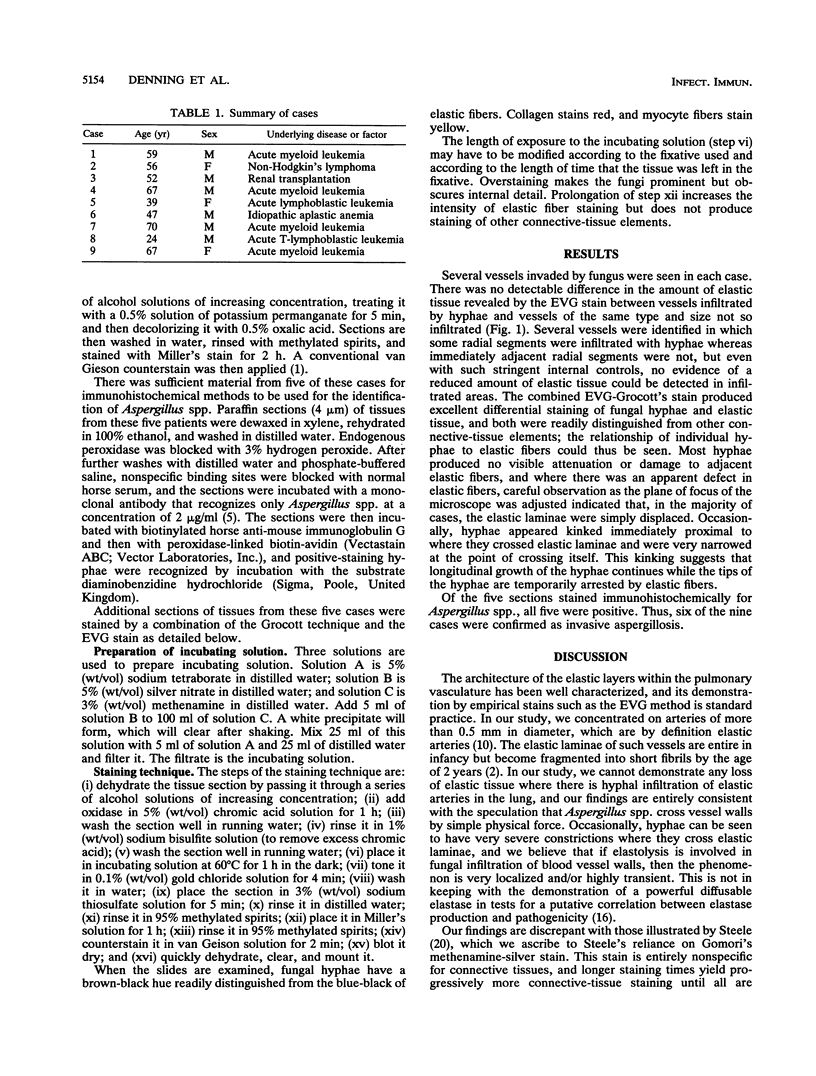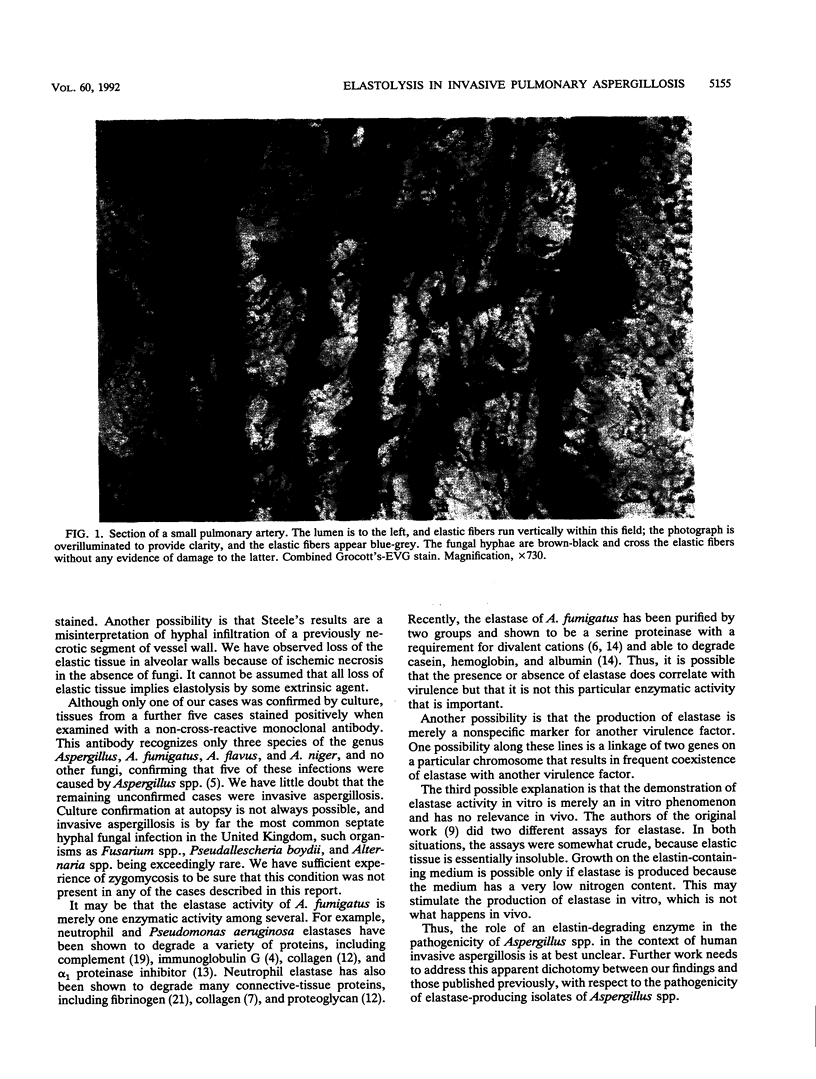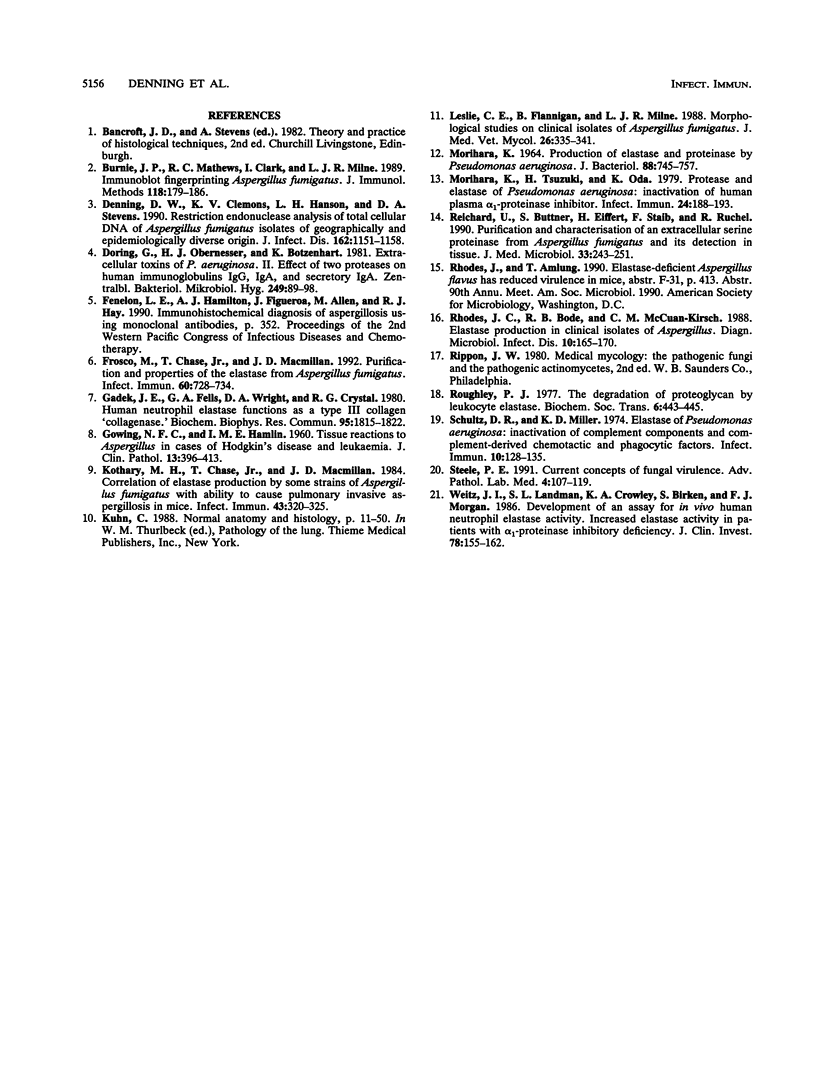Abstract
In experimental studies, the apparent ability of Aspergillus fumigatus isolates to produce elastase in agar plates correlates with their ability to cause invasive pulmonary aspergillosis in mice pretreated with cortisone. Thus, elastase production may govern the pathogenicity of particular isolates. If this is so, then disruption of the elastic layers within blood vessel walls in invasive aspergillosis would be expected. To test this hypothesis, tissue blocks were prepared from nine patients with invasive pulmonary aspergillosis. Separate but immediately adjacent histological sections were stained by the Grocott and periodic acid-Schiff methods for fungal hyphae and by the elastic van Gieson technique for elastic tissue. Comparison of those segments of vessel walls infiltrated by hyphae with those not infiltrated by hyphae showed no overall loss of elastic tissue. Material from five of the cases was also stained with an unconventional combination of histochemical stains, allowing accurate identification of both fungal hyphae and elastic laminae in the same histological sections. The results showed no more disruption of elastic laminae than would be expected from simple physical displacement of elastic laminae. We conclude that if elastolysis contributes at all to invasion of vessel walls by aspergilli, then it seems to be very localized and/or transient.
Full text
PDF



Images in this article
Selected References
These references are in PubMed. This may not be the complete list of references from this article.
- Burnie J. P., Matthews R. C., Clark I., Milne L. J. Immunoblot fingerprinting Aspergillus fumigatus. J Immunol Methods. 1989 Mar 31;118(2):179–186. doi: 10.1016/0022-1759(89)90004-5. [DOI] [PubMed] [Google Scholar]
- Denning D. W., Clemons K. V., Hanson L. H., Stevens D. A. Restriction endonuclease analysis of total cellular DNA of Aspergillus fumigatus isolates of geographically and epidemiologically diverse origin. J Infect Dis. 1990 Nov;162(5):1151–1158. doi: 10.1093/infdis/162.5.1151. [DOI] [PubMed] [Google Scholar]
- Döring G., Obernesser H. J., Botzenhart K. Extrazelluläre Toxine von Pseudomonas aeruginosa. II. Einwirkung zweier gereinigter Proteasen auf die menschlichen Immunoglobuline IgG, IgA und sekretorisches IgA. Zentralbl Bakteriol A. 1981 Mar;249(1):89–98. [PubMed] [Google Scholar]
- Frosco M., Chase T., Jr, Macmillan J. D. Purification and properties of the elastase from Aspergillus fumigatus. Infect Immun. 1992 Mar;60(3):728–734. doi: 10.1128/iai.60.3.728-734.1992. [DOI] [PMC free article] [PubMed] [Google Scholar]
- GOWING N. F., HAMLIN I. M. Tissue reactions to Aspergillus in cases of Hodgkin's disease and leukaemia. J Clin Pathol. 1960 Sep;13:396–413. doi: 10.1136/jcp.13.5.396. [DOI] [PMC free article] [PubMed] [Google Scholar]
- Gadek J. E., Fells G. A., Wright D. G., Crystal R. G. Human neutrophil elastase functions as a type III collagen "collagenase". Biochem Biophys Res Commun. 1980 Aug 29;95(4):1815–1822. doi: 10.1016/s0006-291x(80)80110-0. [DOI] [PubMed] [Google Scholar]
- Kothary M. H., Chase T., Jr, Macmillan J. D. Correlation of elastase production by some strains of Aspergillus fumigatus with ability to cause pulmonary invasive aspergillosis in mice. Infect Immun. 1984 Jan;43(1):320–325. doi: 10.1128/iai.43.1.320-325.1984. [DOI] [PMC free article] [PubMed] [Google Scholar]
- Leslie C. E., Flannigan B., Milne L. J. Morphological studies on clinical isolates of Aspergillus fumigatus. J Med Vet Mycol. 1988;26(6):335–341. [PubMed] [Google Scholar]
- MORIHARA K. PRODUCTION OF ELASTASE AND PROTEINASE BY PSEUDOMONAS AERUGINOSA. J Bacteriol. 1964 Sep;88:745–757. doi: 10.1128/jb.88.3.745-757.1964. [DOI] [PMC free article] [PubMed] [Google Scholar]
- Morihara K., Tsuzuki H., Oda K. Protease and elastase of Pseudomonas aeruginosa: inactivation of human plasma alpha 1-proteinase inhibitor. Infect Immun. 1979 Apr;24(1):188–193. doi: 10.1128/iai.24.1.188-193.1979. [DOI] [PMC free article] [PubMed] [Google Scholar]
- Reichard U., Büttner S., Eiffert H., Staib F., Rüchel R. Purification and characterisation of an extracellular serine proteinase from Aspergillus fumigatus and its detection in tissue. J Med Microbiol. 1990 Dec;33(4):243–251. doi: 10.1099/00222615-33-4-243. [DOI] [PubMed] [Google Scholar]
- Rhodes J. C., Bode R. B., McCuan-Kirsch C. M. Elastase production in clinical isolates of Aspergillus. Diagn Microbiol Infect Dis. 1988 Jul;10(3):165–170. doi: 10.1016/0732-8893(88)90036-3. [DOI] [PubMed] [Google Scholar]
- Roughley P. J. The degradation of proteoglycan by leucocyte elastase. Biochem Soc Trans. 1977;5(2):443–445. doi: 10.1042/bst0050443. [DOI] [PubMed] [Google Scholar]
- Schultz D. R., Miller K. D. Elastase of Pseudomonas aeruginosa: inactivation of complement components and complement-derived chemotactic and phagocytic factors. Infect Immun. 1974 Jul;10(1):128–135. doi: 10.1128/iai.10.1.128-135.1974. [DOI] [PMC free article] [PubMed] [Google Scholar]
- Weitz J. I., Landman S. L., Crowley K. A., Birken S., Morgan F. J. Development of an assay for in vivo human neutrophil elastase activity. Increased elastase activity in patients with alpha 1-proteinase inhibitor deficiency. J Clin Invest. 1986 Jul;78(1):155–162. doi: 10.1172/JCI112545. [DOI] [PMC free article] [PubMed] [Google Scholar]



